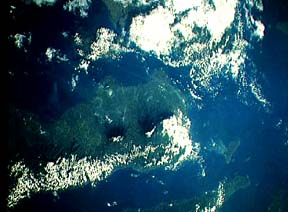
Photo Credit: Jorgen S Aabech
Canlaon volcano (also spelled Kanlaon), the most active of the central Philippines, forms the highest point on the island of Negros. The massive 2435-m-high stratovolcano is dotted with fissure-controlled pyroclastic cones and craters, many of which are filled by lakes. The summit of Canlaon contains a broad elongated northern caldera with a crater lake and a smaller, but higher, historically active crater to the south. The largest debris avalanche known in the Philippines traveled 33 km to the SW from Canlaon. Historical eruptions, recorded since 1866, have typically consisted of phreatic explosions of small-to-moderate size that produce minor ashfalls near the volcano.
Canlaon has 19 historic eruptions between 1866 and 1993. The eruptions are small to moderate in size (VEI=1-2) and explosive.

Space Shuttle photo STS056-0155-0219. April 15, 1993.
This photo looks west across northern Negros. Silay, a Holocene stratovolcano is the northern most cone on the island (obscured by clouds). Mandalagan, also a Holocene stratovolcano, has a small plume on clouds off its summit to the southeast (to the bottom left). Canlaon is near the center of the north part of the island.
Click HERE for information about climing Mt. Kanlaon (external)
Sources of Information:
Neumann van Padang, M., 1953, Philippine Islands and Cochin China. Catalogue of the Active Volcanoes of the World, International Association of Volcanology, 2, Rome, Italy, 49 p.
Simkin, T., and Siebert, L., 1994, Volcanoes of the World: Geoscience Press, Tucson, Arizona, 349 p.